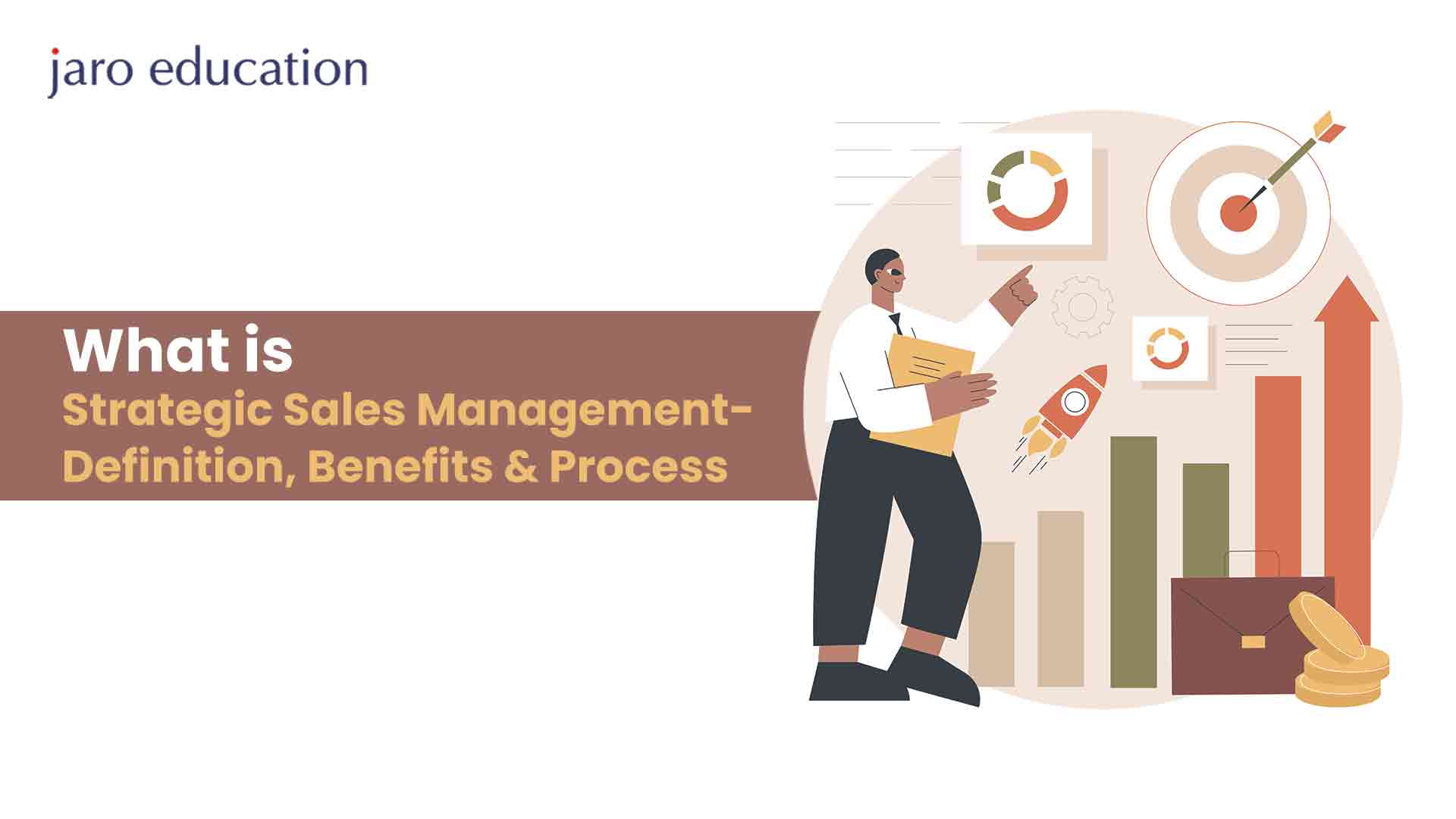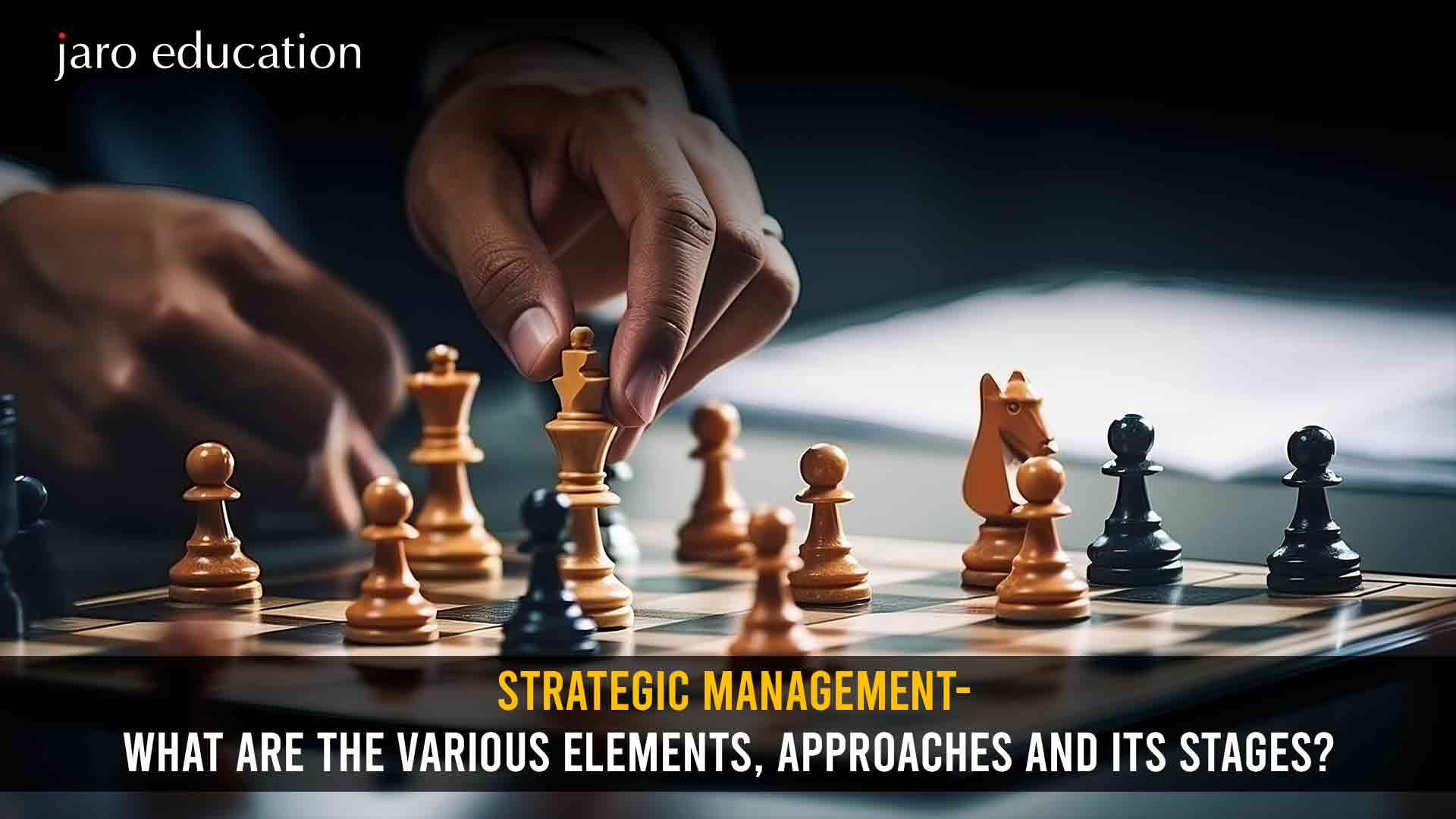Choosing the Right Business Approach with Strategic Management Model
Table of Contents
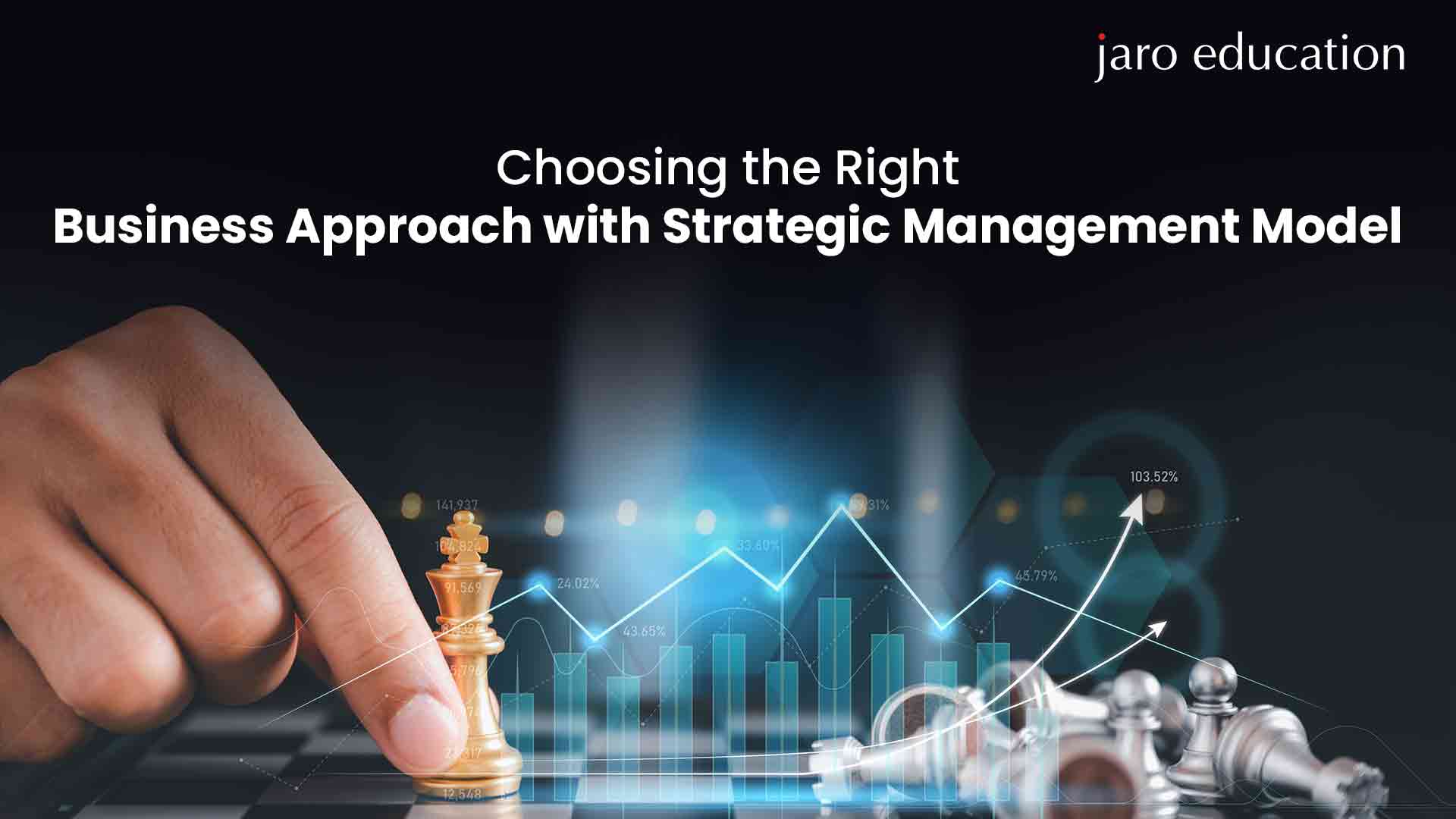
- jaro Education
- 25, December 2023
- 11:00 am
One of the basic requirements for running a business is bringing about an alignment between the people, systems, measures, and sales. An organization has to sync all of these towards the achievement of a common goal for the organization. This is where the strategic management model comes in. It is a framework that organizations use today to make business decisions and plan for the future. It includes setting goals, analyzing the internal and external environment of the organization, planning and implementing strategies, evaluating, and finally, making rectifications as and when required.
Choosing the best strategy for any business requires a careful study of the type of business and its deliverables. Professionals working in the sphere of business management, aiming to lead transformation within global organizations must join a professional program, like the Professional Certificate Programme in Strategic Management offered by IIT Delhi. It is a program that IIM has created for ambitious individuals aiming to work as holistic leaders with the ultimate desire to take any company toward global excellence.
What Is Strategic Management Model?

*SlideGeek
A strategic management model is a framework that helps an organization achieve its goals comprehensively. It mainly focuses on a specific strategy adopted by an organization and involves a thorough analysis of the environments within and outside the firm. Additionally, it focuses on the overall well-being of the organization. The strategic management model integrates areas like marketing, finance, accounting, human resources, IT, and production, to generate favorable consequences for the organization. The model is extremely crucial, as it can assist in the operationalization of strategies. Moreover, it gives business leaders and managers a business pathway to tread on. Also, the model comprises both macro and micro elements of the business entity.
The main components of the strategic management model include:
1. Strategy Development

*12Grids
The main elements that comprise strategy development are the vision, mission, and goals of the organization. Some of the other aspects that are connected to this stage are analysis of the internal and external environments, selection of the right strategies for the organization, competitor analysis, selection of the right strategies for the specific business sector, and many more. This component further includes the vision, mission, goals, objectives, and various levels of analysis for the business.
2. Strategy Implementation
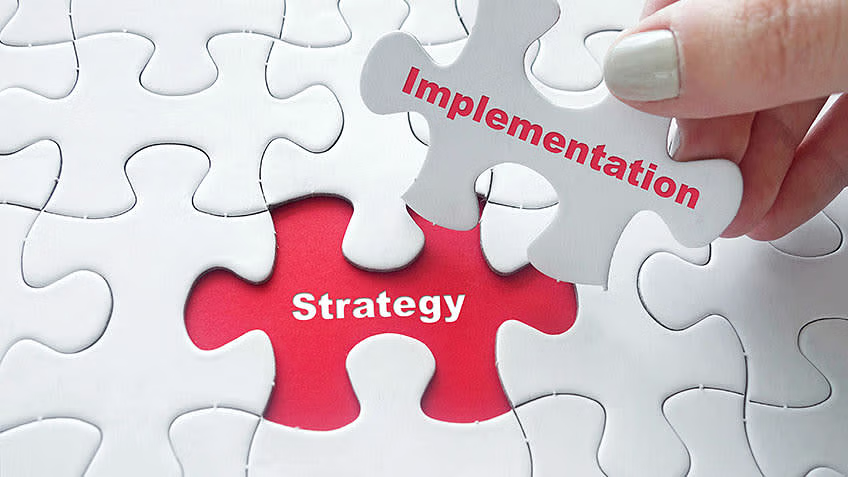
*Simplilearn
Any organization must move on to the implementation stage, without which all the planning and formulation will lead to zero results. Three main micro elements impact the implementation stage, and they are organizational hierarchy, human resources, and organizational systems. It is the stage of action for the organization that will finally yield the desired results. It translates into the business approach, whose fulfillment often leads to various bottlenecks for an organization.
3. Strategy Survey and Control
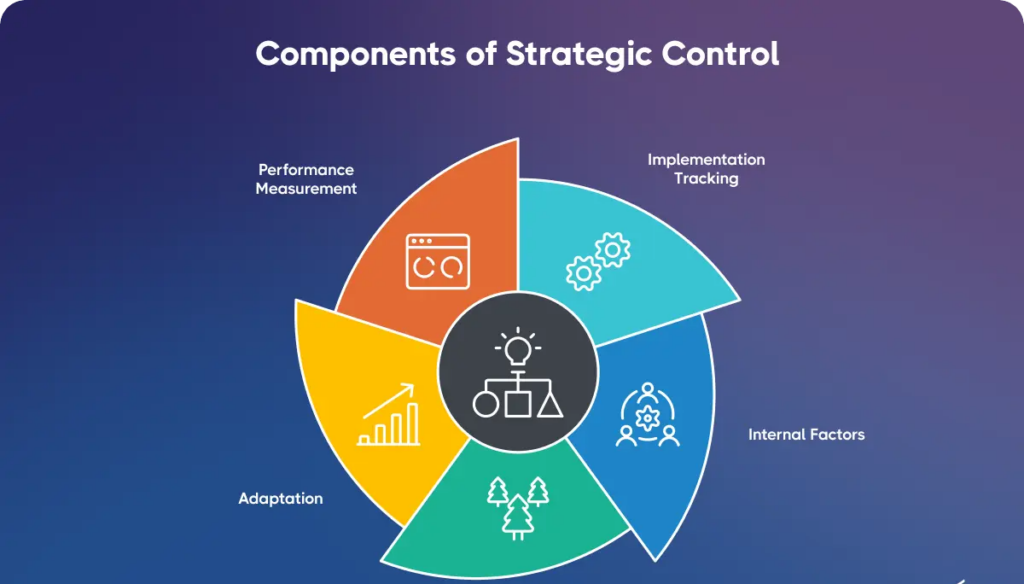
*ClearPoint Strategy
This is the third most important component, which includes exclusive evaluation and measurement of the achieved results against set KPIs according to the business and industry. Moreover, rectification steps are also formulated to yield better outcomes if previous outcomes are not satisfactory. Furthermore, experts associated with the organization do competitor analysis to find out the differences between projected and achieved results over some time.
The strategic management model has to be clearly defined so that everyone involved can understand and co-relate with the strategic management process model in a better and more simplified manner.
Choosing The Right Strategic Approach For Any Business
The organization needs to choose the right strategy for its growth and proliferation. The first step to ascertain the same is to find out the business environment in which the company is operating. Every business environment consists of two dimensions – a predictable one and a malleable one.
These two dimensions of the business environment call for a specific strategic approach. As the business environment has become more diverse than before, picking the right strategy is extremely crucial for business success. There are five broad categories of approach mentioned herein.
1. Classical Approach
It is a traditional approach based on a comprehensive analysis of the business environment and proper planning. In this approach, one will study the phases of analysis, planning, deployment, and execution. It is a highly predictable approach that has gained a lot of popularity across various industries. Industries that have achieved a level of maturity generally use this approach in business.
2. Adaptive Approach
This approach mainly applies to fast-moving sectors where a lot of experimentation is required. It is useful in unpredictable environments, where the technologies and patterns of consumer demand continuously change.
3. Visionary Approach
This is an approach taken by organizations that aim to conquer the market in one strike and finish all sorts of competition by disrupting existing markets. Most organizations that come up with game-changing products and services adopt this strategy. It aims to influence the business environment rather than adapting to it.
4. Shaping Approach
It works in collaborative business environments that are unpredictable yet malleable. Organizations working in such environments are leveraging digital ecosystems to create a base for the future, along with strengthening business interactions.
5. Renewal Approach
Organizations facing fierce competition and other harsh challenges take up this approach. In such a scenario, such organizations take deliberate actions within a limited time to rectify the loopholes in the preconceived strategy. There is very little room for a comprehensive analysis at this point for the organization. Survival is considered very important in this case.
Thus, organizations that can choose the right approach can move towards the zenith of success. However, most businesses today are unable to match their strategy to the environment. The main reason behind this is the possible inclination of most organizations towards the classical approach. Although with a traditional model, organizations cannot cope with the changing business environment with this one single approach in today’s times.
Hence, the choice of the right strategy is extremely important for the survival of any organization in the current times. It also assists the organization in creating systems and structures that drive performance.
Importance Of Strategic Management In Today’s Scenario
The strategic management process model is a business approach that mainly allows the top leadership of the organization to chart out favorable outcomes. It involves the creation of a roadmap that is suitable for the sector and the competitive environment and also leads to positive outcomes. Here are the benefits organizations can witness by having a strategic management model in place.

*EZO
The strategic management model is important, as it plays a transformative role in leading organizations to success. It is the only approach that helps in seeing future potential issues. Moreover, it assists an organization in making decisions based on long-term predictions rather than making baseless assumptions. Besides that, it offers various financial advantages over others. It involves numbers and logical reasoning, allowing organizations to set quantitative measurements of deliverables.
It also impacts the workforce dynamics of the organization, wherein the employees know their ultimate goal. Thus, they are aware of the expectations of the management and strive to reach their targets in an uninhibited manner.
By employing a strategic management model, one can outline the specific deliverables from each department and individual employees, as well. It creates demarcations in job roles and responsibilities. So, there remains no confusion regarding the delegation of tasks and outcomes. It also ensures that seniors in the management cadre can take a common stand on various processes and systems within the organization.
The strategic management model also takes into account the group dynamics within the organization. It encourages group discussions, which result in brainstorming. The ultimate results are favorable for the organization as a whole. As different opinions are weighed against set parameters, organizational leaders can choose one that is right for the organization in the present circumstances.
A proper strategic business approach also leads to better employee motivation and engagement. Employees and managers can understand their roles better, which leads to better outcomes. It results in achievement-oriented behavior. Employees are aware of the changing scenarios surrounding the business and are more flexible, as a result. It also helps organizations to cope with changes. It is one of the biggest fears in the minds of the management as well as employees. Once accustomed to specific processes and systems, employees resist changes more often than not. However, an organization with a clear strategic management process model, implemented while taking everyone into confidence, allows practical route changes.
Steps of the Strategic Management Process
| Step 1 | Identification of Intent | This is the first step towards the implementation of a strategic management model. It involves the setting up of organizational goals and using them as a set parameter to measure outcomes. These mostly follow the SMART goal theory. |
| Step 2 | Analysis of Operational Scenario | Analysis and proper research follow intent. The SWOT analysis tool is used in this context to examine the roadmap and bring about changes as required. |
| Step 3 | Strategy Formulation | This step involves the formulation of the strategy based on the environmental analysis of the business. It helps to create a realistic and actionable plan for the organization. |
| Step 4 | Execution of the Plan | Companies compete through product features, quality, advertising, and marketing |
Why To Choose CEP, IIT Delhi To Elevate Your Strategic Management Career?
Executive education is something all companies need to cultivate a culture that compliments newer technologies and solutions and build a workforce that can maintain and extend with the rapid and dynamic development/changes in the industry.
CEP is an initiative of IIT Delhi focusing on clearing the pathway of training requirements of professionals and enabling professionals to develop unique skills, capabilities, and knowledge for managing complexities, operational and strategic needs and gain competitive advantage.
Besides our open enrollment executive programmes, CEP also provides numerous bespoke programs in an impressive range of areas of expertise to design or transform your organization and to develop your professionals. Built around the specific training needs and objectives of your organization, the bespoke training is the perfect tool to develop the leadership skills and abilities of your professionals.

Eligibility:
- Graduation (10+2+3) from a recognized university (UGC/AICTE/DEC/AIU/State
- Government/recognized international universities) for min 04 years of work experience in any discipline.
Fee Structure:
- Application Fee (non-refundable): INR 2,000/- + GST
- Total Programme Fee: INR 150,000/- + GST
How does Jaro Help You?
Jaro Education understands that education is not one size fits all. That’s why they offer customized mentoring to meet the unique needs of each student. They also provide multiple modes of learning to accommodate different learning styles and schedules. Additionally, Jaro Education offers industry-relevant insights to help students stay ahead of the curve and prepare for successful careers in their chosen fields.
ROI (Return on Investment) Calculator
A valuable tool that Jaro Education offers is the ROI (Return on Investment) Calculator. This calculator helps students measure the profitability or efficiency of their investment in education. By computing the percentage of return expected from the time the investment is made to the time it earns returns or profits, the ROI Calculator helps students assess whether their educational investment is worthwhile.
Overall, Jaro Education provides a comprehensive educational experience that helps students achieve their career goals. Through customized mentoring, multiple modes of learning, industry-relevant insights, and the ROI Calculator, Jaro Education empowers students to make informed decisions about their education and career paths.
Conclusion
In the ever-changing business scenario, a proper strategy can only lead an organization to the zenith of success. The strategic business model serves as the framework for any business to work on. A ship without a destination reaches nowhere. So, if there is no goal or objective, no business can succeed. It also involves making important business decisions and resolving issues, apart from taking advantage of opportunities. Leaders are also better enabled to take the organizations in a specific direction without any ambiguity.
Frequently Asked Questions
A Strategic Management Model is a framework used by organizations to formulate, implement, and evaluate strategies that help them achieve their long-term goals. These models offer structured approaches for businesses to assess internal and external factors, allocate resources effectively, and ensure sustainable growth. Some popular models include Porter’s Five Forces, SWOT analysis, and the BCG Matrix.
A Strategic Management Model is a framework used by organizations to formulate, implement, and evaluate strategies that help them achieve their long-term goals. These models offer structured approaches for businesses to assess internal and external factors, allocate resources effectively, and ensure sustainable growth. Some popular models include Porter’s Five Forces, SWOT analysis, and the BCG Matrix.
There are several strategic management models, each serving different purposes:
- Porter’s Five Forces: Analyzes industry competitiveness.
- SWOT Analysis: Assesses internal strengths, weaknesses, and external opportunities and threats.
- BCG Matrix: Helps in portfolio analysis and resource allocation.
- PESTLE Analysis: Examines external factors (political, economic, social, technological, legal, and environmental).
- Ansoff Matrix: Guides growth strategies based on products and markets.
- McKinsey 7-S Framework: Analyzes seven internal factors to ensure organizational alignment.





